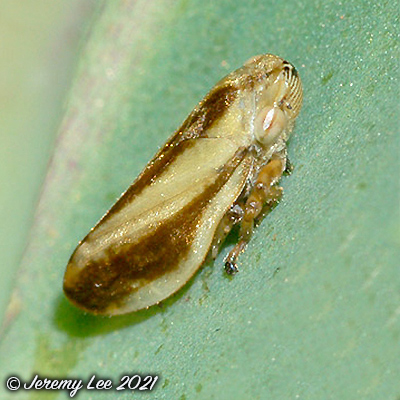
 |
|
Scientific Classifications explained » Amphibians » Ants » Aphids » Bees » Beetles » Birds » Bugs » Butterflies » Caterpillars » Damselflies » Dragonflies » Earwigs » Flies » Frog/Leafhoppers » Fungi » Galls » Grasshoppers » Harvestmen » Hoverflies » Lacewings » Ladybirds » Leaf Mines » Lichens » Mammals » Millipedes » Mosses » Moths » Sawflies » Slugs » Snails » Spiders » Trees & Shrubs » Wasps » Wild Flowers » Woodlice » Postboxes |
UK Nature > Frog/Leafhoppers > Neophilaenus lineatus

Scientific Name: Neophilaenus lineatus Common Name: Lined Spittlebug Neophilaenus species can be separated from Philaenus by the straight costal margin in the basal two-thirds of the forewing; there are several UK species. With a length of 5-7mm, Neophilaenus lineatus can be identified by the pale line running down the outside edge of the forewing, and by the central, anterior 'plate' on the vertex which is wider than long (the latter feature separating it from the similar, but rare Neophilaenus longiceps, which is restricted to salt-marshes). The apex of the scutellum is normally dark, and the face has dark transverse lines, and a dark midline. There is a dark form that occurs in certain populations living on purple moor grass Molinia caerulea. A very common grassland species across the UK. Adults are active June to November, sometimes overwintering. |
|

https://www.uknature.co.uk is a website dedicated to showing the immense diversity of UK nature and wildlife. Our vast range of habitats, from lowland arable to snow covered mountains, from storm-ravaged coastlines to peaceful inland freshwater lakes and rivers, from dry, sandy heaths to deciduous and coniferous forests, all these habitats contribute to the abundance of UK nature. We have wild birds in huge numbers either residing or visiting our shores (597 recorded species as at July 2013) and we must also not forget the humble back garden with its grass lawns, flower beds filled with nectar rich flowers, shrubs and trees, all designed to attract huge numbers of insects such as bees, moths, butterflies and hoverflies; and finally the small ponds which provide safe havens for frogs, toads, newts and even slow worms and grass snakes. www.uknature.co.uk is the showcase for my personal passion, photographing uknature in all its glory. I sincerely hope you all enjoy the fruits of my labours. This site and all images contained therein is © Jeremy Lee 2004 - 2025. All Rights Reserved. Site design by Jeremy Lee. Site development & IT Support by Stuart Lee. |